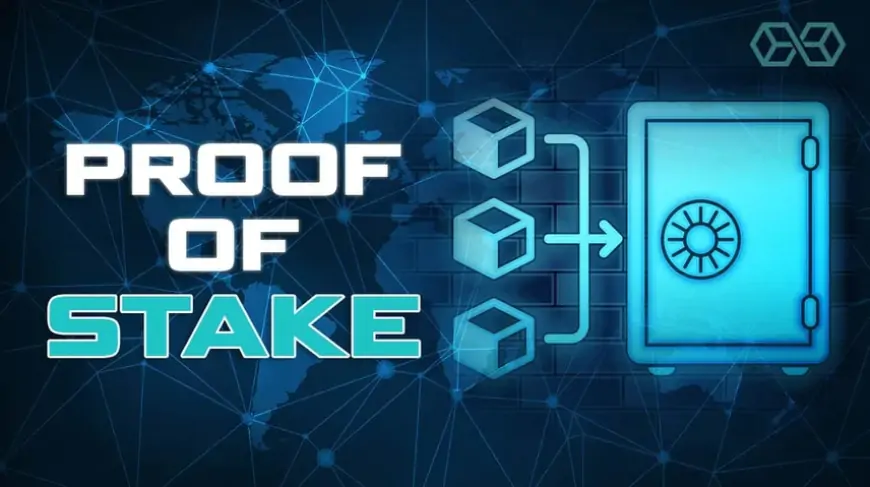What does Proof-of-Stake (PoS) mean in crypto? A comprehensive guide
Discover how Proof-of-Stake enhances blockchain security with reduced energy consumption and safeguards against potential 51% attacks.

Understanding Proof-of-Stake (PoS)
Proof-of-stake (PoS) is a blockchain consensus mechanism used to validate transactions and create new blocks. Unlike proof-of-work (PoW), which relies on computational power and energy consumption, PoS selects validators based on the amount of cryptocurrency they hold and are willing to "stake" as collateral. Validators are chosen to create new blocks and validate transactions based on their stake, with higher stakes typically increasing the likelihood of selection.
PoS aims to address several issues within the cryptocurrency industry:
Energy efficiency: PoW algorithms, such as those used by Bitcoin, require significant computational power and energy consumption for mining. PoS reduces the environmental impact by eliminating the need for intensive computations.
- Decentralization: PoW can lead to centralization of mining power in the hands of a few entities with substantial computing resources. PoS encourages decentralization by distributing influence based on participants' stakes in the network.
- Security: PoS mechanisms typically require validators to stake their own tokens as collateral. This creates a financial incentive for validators to act honestly and secure the network, as they risk losing their staked tokens if they attempt to validate fraudulent transactions.
- Scalability: PoS is often considered more scalable than PoW because it does not rely on intensive computational tasks. This can potentially increase transaction throughput and reduce confirmation times.
- Economic fairness: PoS can promote a fairer distribution of rewards compared to PoW, where miners with more computational power often receive more rewards. In PoS, rewards are distributed based on the amount of cryptocurrency staked, aligning incentives with long-term network health.
In summary, PoS represents a shift towards more energy-efficient and potentially more scalable blockchain consensus mechanisms compared to PoW. It aims to enhance security, decentralization, and economic fairness within the cryptocurrency ecosystem.
Proof-of-stake (PoS) is a blockchain consensus mechanism that reduces the computational workload for verifying blocks and transactions compared to proof-of-work (PoW). Instead of relying on intensive computations, PoS leverages validators who are chosen based on the cryptocurrency they hold and stake as collateral. These validators are randomly selected to validate transactions and create new blocks.
To become a validator in PoS, coin owners must stake a specific amount of coins, which serves as collateral. For example, Ethereum requires 32 ETH to operate a node. Validators collectively validate blocks, and once a sufficient number agree on the block's accuracy, it is finalized and closed.
Different PoS systems may employ varying methods to achieve consensus. For instance, Ethereum's future upgrade, sharding, will involve validators verifying transactions and adding them to shard blocks, which require a smaller group of validators (a voting "committee"). Upon validation of shards and consensus from two-thirds of validators, the block is closed.
Overall, PoS enhances blockchain security and efficiency by reducing energy consumption and decentralizing block validation through stake-based mechanisms.
Differences between Proof-of-Stake and Proof-of-Work
Both Proof-of-Stake (PoS) and Proof-of-Work (PoW) are consensus mechanisms crucial for synchronizing blockchain data, validating transactions, and maintaining the integrity of the network. However, they differ significantly in their operational approaches and associated implications.
In PoS, individuals who validate blocks are known as validators. These validators check transactions, confirm activity, participate in voting processes, and maintain records on the blockchain. On the other hand, PoW involves miners who solve complex mathematical puzzles to validate transactions and add new blocks to the chain. Miners in PoW are rewarded with cryptocurrency for successfully solving these puzzles.
To participate as a block creator in PoS, validators must possess and stake a certain amount of coins or tokens in the blockchain network. In contrast, PoW miners invest in specialized processing equipment and incur substantial energy costs to power their operations.
The high costs associated with equipment and energy in PoW mechanisms serve as a barrier to entry for mining, which enhances the security of the blockchain network. In contrast, PoS reduces the computational resources required to validate block information and process transactions. Additionally, PoS eliminates the competitive rewards structure inherent in PoW blockchains.
In summary, while both PoS and PoW effectively secure blockchains, PoS reduces computational requirements, lowers network congestion, and eliminates the competitive mining incentives characteristic of PoW mechanisms.
Objectives of Proof-of-Stake
Proof-of-stake aims to alleviate network congestion and address environmental sustainability issues associated with proof-of-work (PoW). Unlike PoW, which fosters competition among miners seeking transaction verification rewards, PoS substitutes computational power with staking as a means to validate transactions. This change significantly reduces energy consumption since miners no longer require extensive, energy-intensive hardware setups to gain advantages. For instance, Ethereum's shift from PoW to PoS resulted in a 99.84% reduction in blockchain energy consumption.
Security in Proof-of-Stake
Often feared by cryptocurrency enthusiasts, the 51% attack remains a potential threat in PoS systems, although its occurrence is considered unlikely. Unlike PoW, where a 51% attack involves controlling more than half of the network's mining power, in PoS, an attacker would need to own 51% of the staked cryptocurrency.
Acquiring 51% of staked cryptocurrency is prohibitively expensive. In Ethereum's PoS system, for example, if a 51% attack were attempted, honest validators could vote to disregard any manipulated blockchain and penalize the attacker(s) by burning their staked ETH. This creates strong incentives for validators to uphold the integrity of the cryptocurrency and its network.
While specific security measures in PoS are not extensively publicized to avoid exploitation, most PoS systems incorporate additional safeguards that contribute to the overall security of blockchains and PoS mechanisms.












































